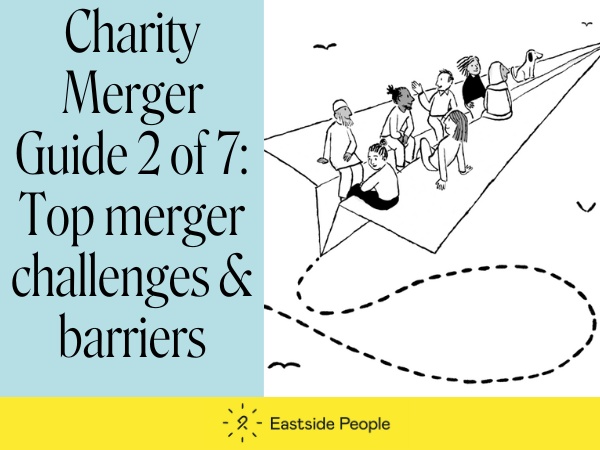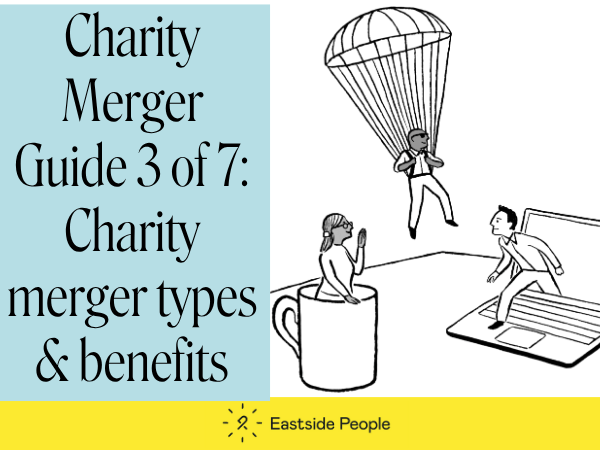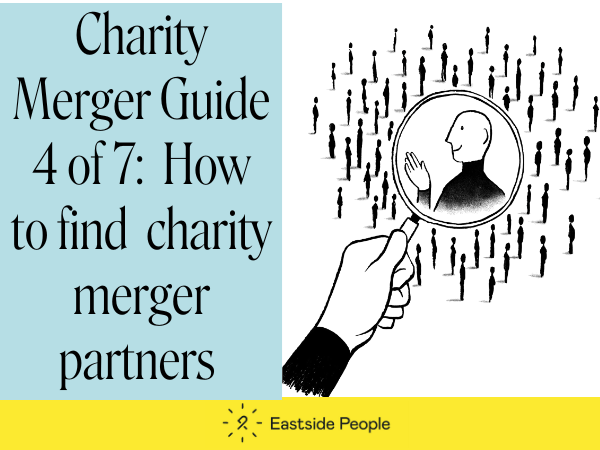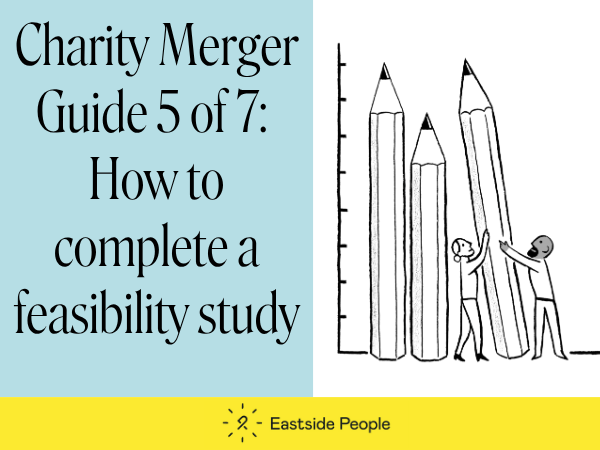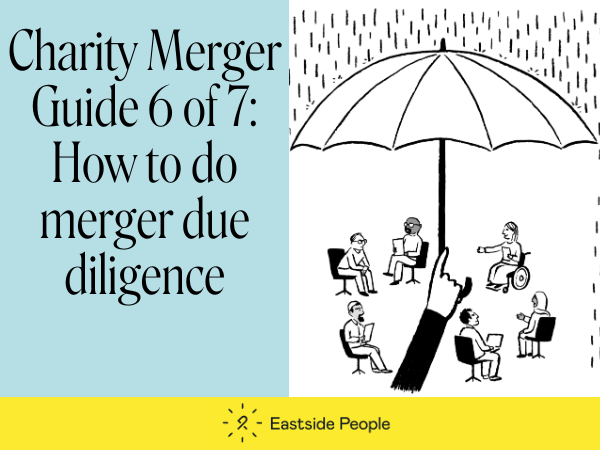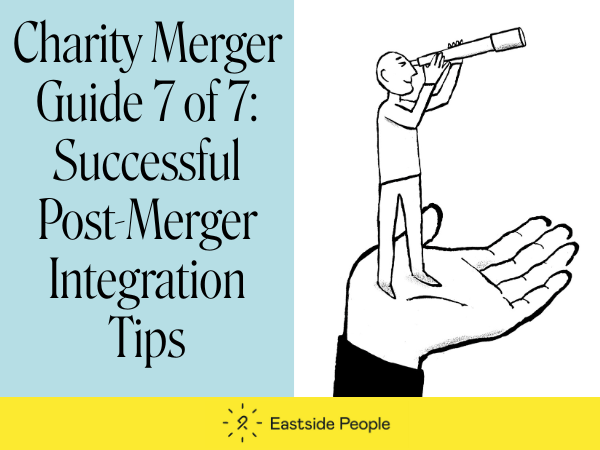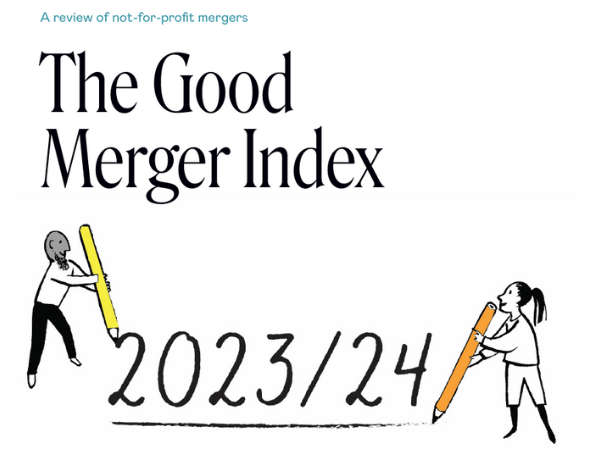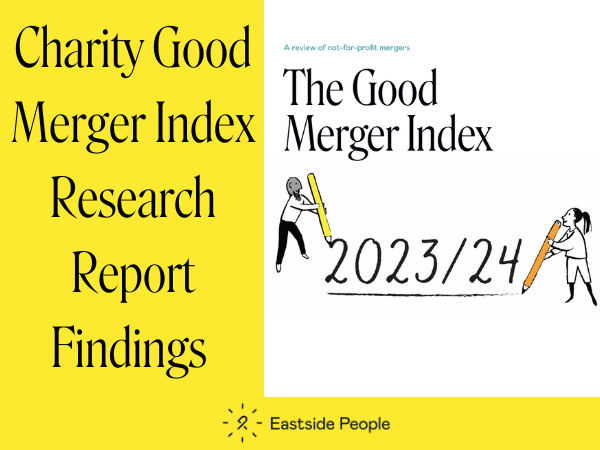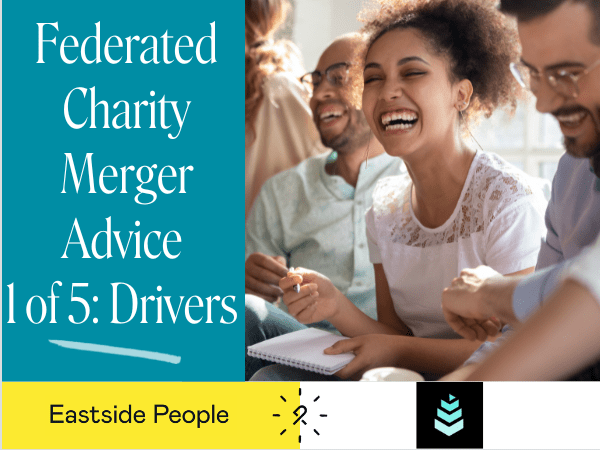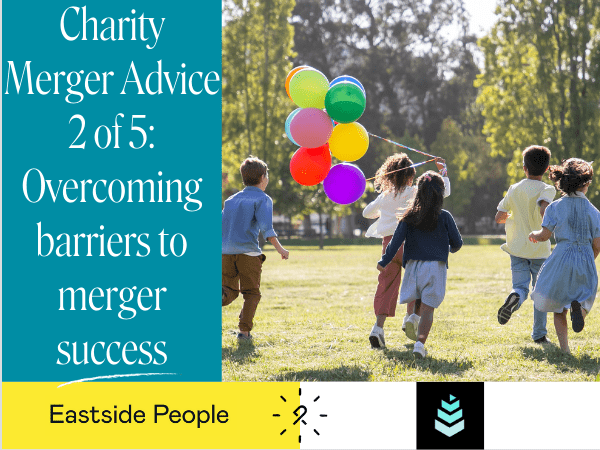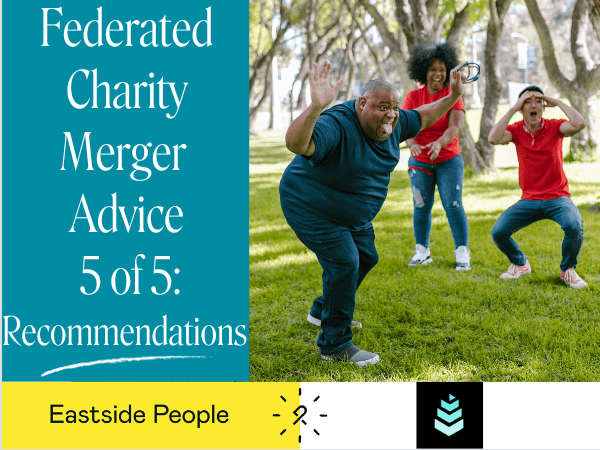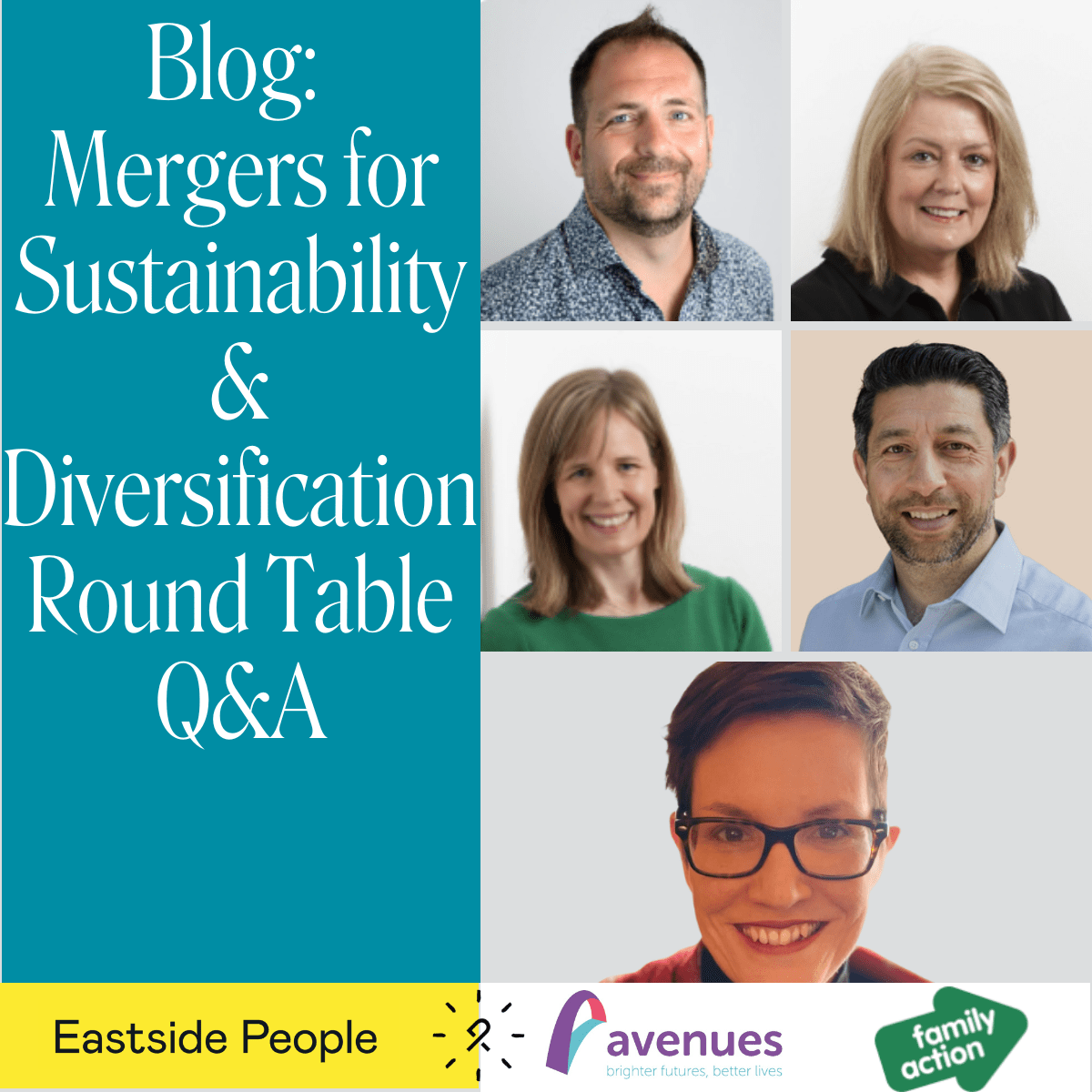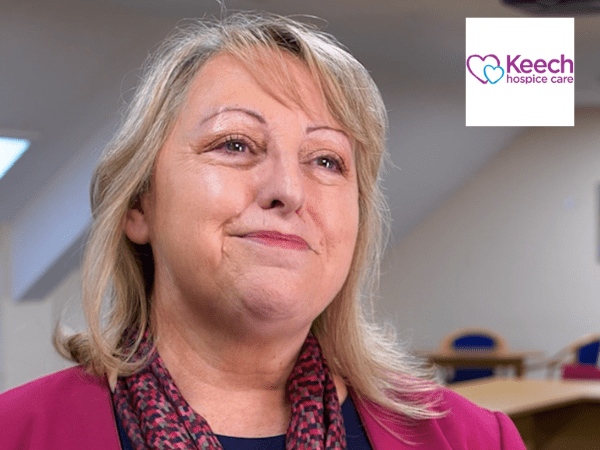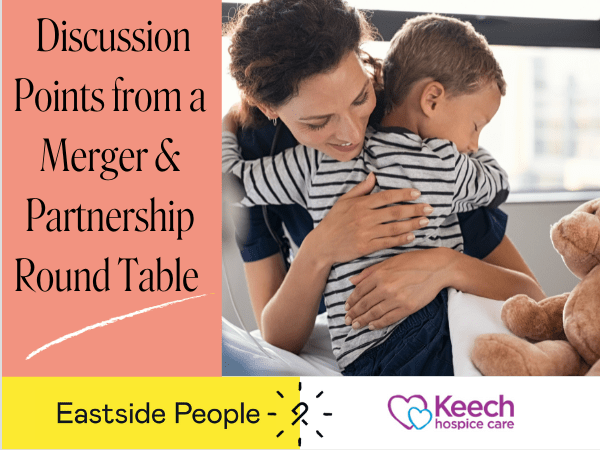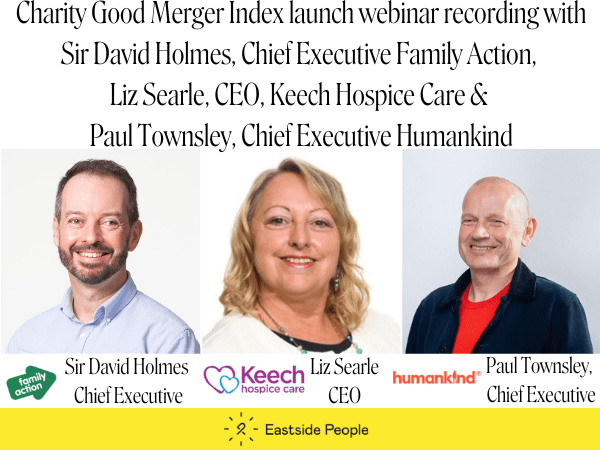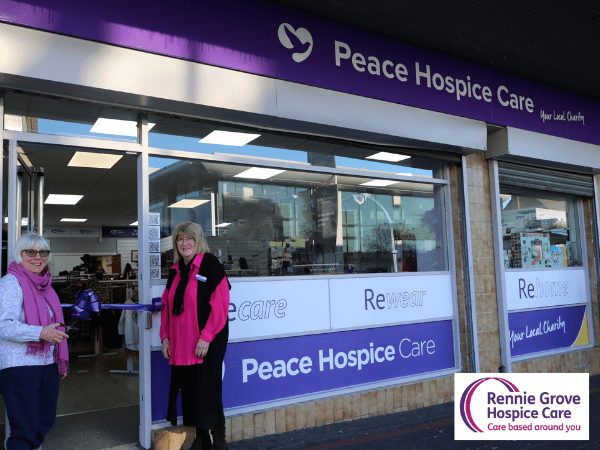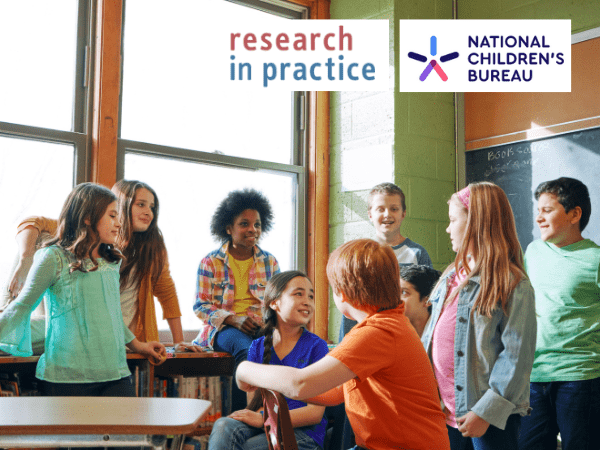Successful mergers can have a transformative effect changing the scale, reach and prospects of an organisation and creating a better deal for the people that rely on a charity’s services. At Eastside People, we have been supporting charities and other not-for-profit organisations through partnerships and mergers for over a decade. In that time, we have witnessed organisations embark on partnerships and mergers for a myriad of reasons.
The Good Merger Guide was created by Eastside People to:
- Highlight the main questions to consider before embarking on a merger
- Provide step by step advice on the three stages of managing a merger.
We have taken some of the best advice and guidance from the Good Merger Guide focusing particularly on the practical and technical aspects of mergers. The 7 articles that make up the set are a must read for anyone in a not-for-profit organisation considering merger as a possible option and wanting to know more about what is involved. This is article 1 of 7.
The 7 most common benefits of merger, with case study examples
In this article, we summarise the benefits that most commonly motivate charitable or not-for-profit organisations to consider mergers and bring them to life through real-life success stories.
1. Greater Profile and Voice for Campaigns
Merging can amplify an organisation’s impact and reach.
For example, the merger of The Mix and Mental Health Innovations (MHI) brought together two of the UK’s leading digital charities. MHI provided digital tools, support and resources, and had significant profile-raising and scaling capabilities – which it used to power Shout, the UK’s only free, 24/6 crisis text line. Meanwhile, The Mix had extensive experience working with young people, a key demographic that MHI wanted to engage with its services, including Shout. Together, they are now able to reach more people, in particular young people, delivering far greater impact together than either organisation could achieve alone.
2. Economies of Scale and Back-Office Savings
Merger can bring significant cost savings.
Some common examples of simple savings include:
- Reduction of office and capital costs
- Salary savings within the senior leadership team
- Only having to produce a single annual report.
Efficiencies will vary between organisations, so it is essential to assess these carefully, avoiding any unsupported assumptions, especially if cost savings are a core strategic reason for merging.
Moreover, while often cited as a primary motivation, it’s crucial to carefully evaluate potential savings before proceeding. Many strategic partnerships do ultimately bring some savings, but these rarely come straight away. Often, in the first instance, merger brings additional costs – investing the necessary time, effort and financial expenses related to the process are crucial to its success.
The merger of Bedford Hospice and Keech Hospice Care is a clear example of two organisations that successfully joined forces to achieve this strategic benefit. Securing a future for Bedford Daycare Hospice was a primary motivation for the merger, as was a desire to ensure more people could benefit from hospice services in the local area. Careful financial analysis in the early stages of the process gave the organisations confidence that the merger would enable them to be more robust and resilient. When the anticipated savings did then materialise, the merged organisation was able to expand services in the area, delivering the intended, overarching benefit of the merger.
3. Expanded Geographic Reach or Scope
For many organisations, merger offers a real opportunity to reach new geographical areas.
Mergers can rapidly expand an organisation’s scope, providing a real incentive to merge for organisations pursuing growth.
When Community Integrated Care (a national organisation) merged with Age Exchange, they gained a fully developed research arm. This saved Community Integrated Care the time and resources required to build this for themselves from scratch. At the same time, the merger connected Age Exchange – a local charity based in Bromley – with Community Integrated Care’s network of homes across the country, expanding its reach nationally.
4. Funding Diversity
When organisations with different sources of income or funding models merge, this diversifies income streams and can boost financial resilience.
For instance, an organisation that does not have its own fundraising or retail arm, might decide to join forces with one that does, creating a more sustainable future together. Similarly, an organisation that is heavily reliant on income from one funding source, can build financial resilience by joining forces with another organisation that receives income from a different source, or uses a different funding model altogether.
The partnership between NAViGO, a social enterprise providing a range of mental health services, and Care4All, a social care provider, demonstrates how mergers can open up new areas of service delivery, bringing in new funding streams that reduce reliance on single sources of income.
5. Creation of a Continuum of Services
Often, organisations that provide similar or related services, or support similar or related beneficiary groups, decide to join forces to improve the continuity of the service these beneficiaries experience.
For example, the British Liver Trust and Children’s Liver Disease Foundation were the UK’s two leading liver health charities. By uniting, the organisations were better able to ensure seamless care and support from paediatric to adult liver disease, with the ultimate goal of improving quality of patient care. Their merger showcases how organisations can create a seamless support system across age groups, providing comprehensive care from childhood through adulthood.
6. Improved Talent Pool
Through merger, organisations can fill skill gaps, bringing diversity of experience, increased technical capability and additional sector knowledge and expertise into their team.
This is what happened when We Are With You (then called Addaction) merged with Kent Council on Addiction who were delivering mental health and drug and alcohol support services. The merger brought considerable additional expertise into the team, with a number of KCA executives taking on roles in the group leadership team, and adding vital trauma-informed support across their services.
In this way, merger can bring together teams with diverse skills and knowledge, enhancing both service offerings and organisational capabilities.
7. Service Innovation
By bringing together diverse expertise, ideas and resources, merger can enhance organisations’ ability to innovate and improve services.
For example, when Research in Practice (RiP) merged into the National Children’s Bureau (NCB), it brought expertise working with and for professionals in the social care, health, criminal justice and higher education sectors into the organisation. This complemented NCB’s already significant expertise and experience in developing practice and policy, taking an evidence-informed approach to build better childhoods. Bringing RiP into the NCB family widened the organisation’s expertise in reaching and supporting adults, parents, families and carers, whose welfare often directly impacts the lives of children and young people.
While it’s crucial to approach mergers thoughtfully, with careful planning and a well-informed understanding of how to ensure the best outcomes for all stakeholders involved, merger can enable organisations to do more together – to be more ambitious, innovative and impactful.
Indeed, a successful merger can transform an organisation into a powerhouse of positive change, ultimately making it better able to serve its beneficiaries – and at Eastside People, we believe that the prospect of improving services for beneficiaries is the overarching reason to consider merger.
If you are considering embarking on a merger journey, we recommend that as a very first step, you identify the strategic benefits you hope to achieve. This will provide you with a clear ‘why’ – your reasons to believe in the merger.
Next Steps:
We feel that the sooner you start thinking about merger and partnership the greater the chance of success.
We are here to help you wherever you are in the merger journey. Contact us for a free, completely confidential 30-minute advice session with one of our merger experts to discuss how to take the next steps.
Find out more about our charity and not-for-profit merger and partnership consultancy services.
While the Good Merger Guide is available for download, as this was originally created in 2014 it contains older case studies and references. Please refer to the latest Good Merger Index and our website merger topics section for our latest case studies, blogs, insights and other merger-related content.
Read the other articles in our ‘how-to’ charity merger series.



